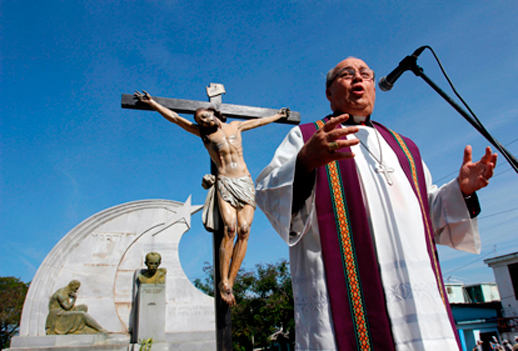by Patricia Zapor

HAVANA (CNS) – The Catholic Church that Pope Benedict XVI will visit March 26-28 is, to put it simply, more.
Since Pope John Paul II’s visit in 1998, the church is more unified, more public, more likely to work with the government in accomplishing specific goals, more involved in providing assistance to the Cuban people, more comfortable in its place in society. Its bishops, priests and laypeople, while still wary of pushing official tolerance too far, are more confident in teaching the faith in a way they believe can help shape the future of all of Cuba.
Above all, it is more hopeful.
In interviews and casual conversations with Catholic News Service in mid-February, just about everyone – including nonbelievers – in the places Pope Benedict will visit expressed hope for what his trip might trigger. People said they saw important changes the last time a pope visited Cuba, and they have hopes for what this trip might bring.
They spoke of a Cuban people around the world unified by the Virgin of Charity of El Cobre – La Caridad as she is affectionately called. Pope Benedict’s stop in Cuba has been described by the Cuban bishops as a personal pilgrimage to share in this year’s celebrations of the 400th anniversary of La Caridad.
“It is a blessing for all Cubans,” said Juan Alberto Alba, whose infant godson was one of 33 children baptized Feb. 11 at the Shrine of Our Lady of Charity of El Cobre, where the pope will visit March 27. “In the past it was bad to be Catholic, but the faith has grown.”
“The Cuban church is a church with hope in Christ,” said Msgr. Ramon Suarez Polcari, chancellor of the Havana Archdiocese. That sense of hope has become more obvious in the past few years.
It has happened in low-profile ways such as in the growth of thriving home-based missions and the expanded presence of Caritas, the church’s development and relief agency. Among higher-profile events, a new seminary opened outside Havana in 2010; Havana Cardinal Jaime Ortega Alamino mediated the release of more than 50 political prisoners; and processions and prayer services across the country drew thousands of people to pay homage to a statue of the nation’s patroness.
New church efforts include the country’s first MBA program, just one offering at the not-quite-open Father Felix Varela Cultural Center. It fills an education gap in a country where only in the last few months have individuals been allowed to own businesses, and few people have the necessary background to run one.
Roberto Veiga Gonzalez, editor of Espacio Laical, a widely respected magazine for the laity published under the auspices of the Archdiocese of Havana, said that “every day the church is more integrated into society.”
Part of Cuban Culture
Catholicism is “a moral, religious reference point for many sectors of Cuba, even when they are not Catholic. Catholicism is a part of Cuban culture,” he said.
Veiga explained that in 19th-century gatherings, “the Cuban nation began to be dreamed of at the Catholic seminary.” So it is natural that the church is playing a role in helping bring about change now, by creating a climate for dialogue. That seminary now houses the Varela Cultural Center, a program of the church intended to be a place for all Cubans to share culture and dialogue.
While optimism is palpable, the picture is not uniformly rosy.
Everyday life in Cuba is a struggle for most people. Salaries are low; the base wage is about $20 a month. Food and other resources are often in short supply and expensive. Few people have access to costly – and bad – Internet and cell phone service. The government controls what news gets in and who can leave the country. Plenty of people spend time in Cuban prisons for criticizing the government.
Though the church estimates 60-70% of Cubans are Catholic, attendance at weekly Mass remains low, in single digits as a percentage of the population. A majority of children are baptized, but far fewer receive other sacraments. Catholic funerals are popular, however.
So much has changed about the attitude toward Catholicism since 1992, when the government dropped its official designation as atheist, that even the biography of President Raul Castro on Wikipedia lists his religion as “Roman Catholic (formerly atheist).”
But a series of polls done for the church in 2002-2003 as part of preparations for a pastoral plan found that 75% of practicing Catholics were unfamiliar with the national ecclesial “encuentro” of 1986 that is considered a turning point for the Cuban church’s pastoral style.
Gustavo Andujar, cultural director of the Varela Cultural Center, set to fully open next year, said that means three-quarters of practicing Catholics “were not ‘historic’ Catholics, but late-comers, with little if any formation and without a deeply rooted sense of belonging to the church.”
